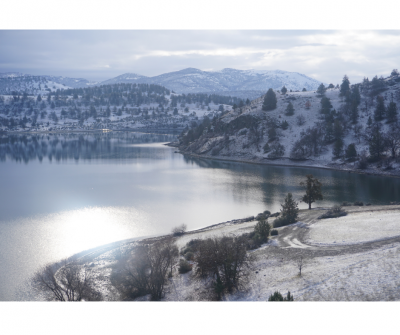Water Quality Memo March 2024
Drawdown of the three reservoirs along the Klamath River in Oregon and California as part of the Lower Klamath Dam Removal Project (Project) began in January 2024. Following the approved project planning and environmental documents, water from JC Boyle, Copco 1, and Iron Gate dams were released through spillway gates and adit tunnels, allowing for the controlled draining of the reservoirs. As noted in the approved environmental documents, including the Final Environmental Impact Statement (FEIS 2022), and Final Environmental Impact Report (FEIR 2020), as well as outlined in the Reservoir Area Management Plan (RAMP) (December 2022), no large-scale assisted sediment removal from the reservoir footprints is proposed as part of the project activities. The estimated amount of sediment that has accumulated in the project reservoirs is approximately 15.5 million cubic yards (4.3 million tons), with more than half of this volume accumulated in the Copco 1 reservoir (FEIS 2022). According to the KRRC project plans, “For a median water year, hydraulic modeling predicted that approximately half of the stored sediment would naturally erode and vacate the Reservoir Area (USBR, 2011b)” (RAMP 2022). The small-scale assisted sediment evacuation proposed at Iron Gate and Copco 1 reservoirs is focused on “high priority tributaries,” with work only occurring between January 1 and March 15, 2024. The high priority tributaries identified by the Klamath River Renewal Corporation (KRRC) are Spencer Creek, Beaver Creek, Jenny Creek, Scotch Creek and Camp Creek.
With approvals from the regulatory agencies, the project plan for sediment transport is to allow the reservoirs to naturally release the accumulated sediments via drawdown, subsequent rain events, and erosion. As stated in the FEIS, 2022:
"Drawdown would erode and mobilize sediments in the reservoirs primarily during the period of the drawdown… Interior and California DFG (2012) estimated that 36 to 57 percent of the accumulated sediment in the reservoirs would be mobilized, depending on hydrological conditions (i.e., flow magnitude and duration) during drawdown and dam removal. Additional erosion and mobilization of fine sediments could occur while the riverbed in the reservoir stabilizes in the following year but would likely be indistinguishable from the background sediment regime… The fine sediments in the reservoirs not eroded during drawdown and dam removal would consolidate on the terraces above the active channel. These areas would be stabilized through vegetation, engineered slope improvements, and other BMPs, as specified in the RAMP. Drawdown of the four reservoirs would release an estimated total of 1.5 to 2.4 million tons of sediment (table 3.1-3). The sediment mobilized from the reservoirs during drawdown is expected to be transported by the river to the ocean mostly as suspended sediment because most of it is predominantly fine-grained composition (silt and clay). Sand and coarser material (approximately 16 percent) would be transported more slowly, depending on the frequency and magnitude of flows and storage in the channel bed."
The increased turbidity and sediment transport occurring during the drawdown phase of the dam removal project, and during precipitation/erosion events prior to vegetation establishment in the reservoirs, has resulted in public health concerns related to heavy metals and other undesirable water quality constituents. While KRRC is responsible for water quality sampling (both continuous monitoring and grab sampling), as part of the project’s permit conditions (such as stated in the State of California 401 Water Quality Certificate from the State Water Quality Control Board [SWQCB]), the constituents monitored and analyzed by KRRC are for the protection of the aquatic environment. The purpose of KRRC’s water quality monitoring is not to monitor the effects of the project on human health.
Therefore, the Siskiyou County Board of Supervisors directed the Siskiyou County Environmental Health Division to collect water quality grab samples from the mainstem of the Klamath River for analysis of constituents that may be harmful to public health. The purpose of this memorandum is to provide the public with information on the water quality samples taken by the County and to give context and an analysis of the results regarding heavy metals.
Please view the Memorandum for more information.


